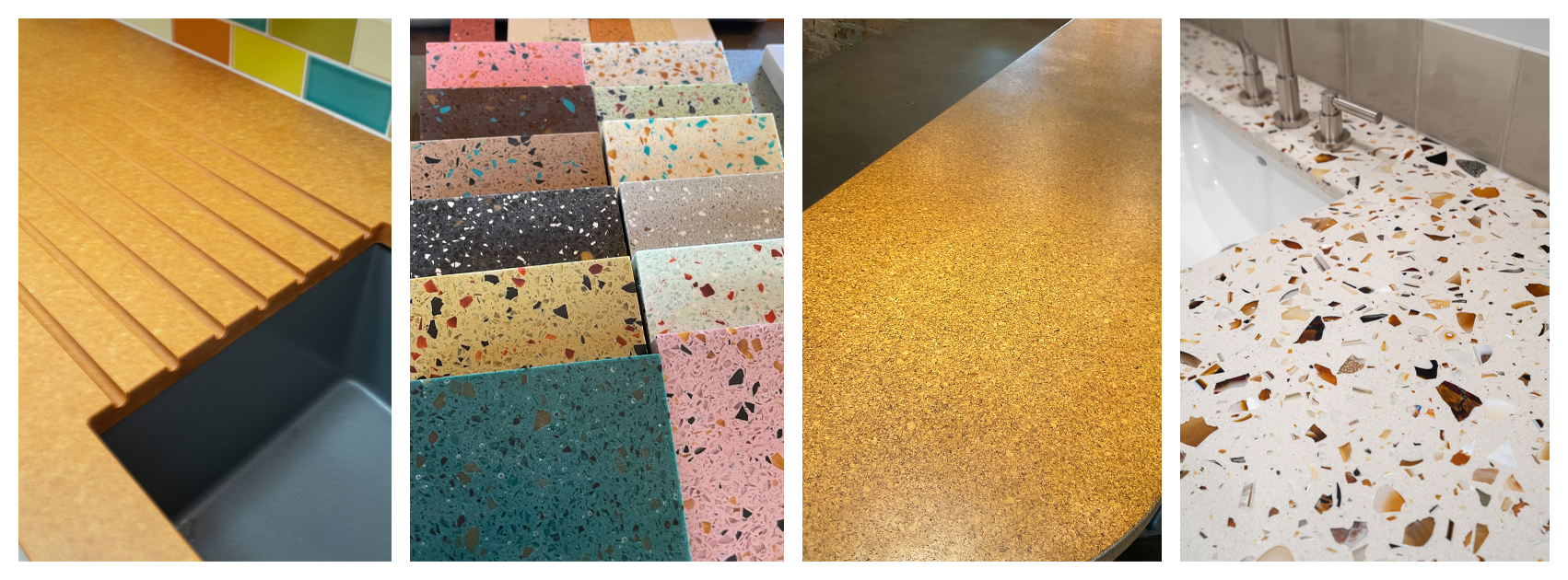
How Do I Maintain My New Countertop?
February 27, 2024
We’re often asked about the care and maintenance required for our unique countertop offerings, it’s a common misconception that these eco-friendly options demand more upkeep compared to traditional surfaces like granite or marble. While some of them do have specific maintenance needs, we’re here to reassure you: routine upkeep isn’t as intimidating as it might seem. With each of our countertops we have detailed guides to help you decide which option might work best in your home and then how to maintain the beauty of your surfaces for years to come.
Know Your Material:
Before diving into care and maintenance routines, it’s crucial to understand the specific material your countertop is made from. Each material has its own set of characteristics and requirements. Whether it’s recycled glass, paper composite, or sustainable wood, familiarize yourself with the properties and care instructions for your countertop material.
General recommendations for all countertop care:
-Avoid abrasive cleaners (like bleach) or scouring pads, as they can scratch the surface or remove the sealer.
-Use a mild detergent or liquid soap with a damp cloth to clean.
-Promptly clean up spills, especially from acidic substances like citrus juices, wine, or vinegar.
-Use trivets or hot pads to protect the countertop from hot pans or dishes, as extreme heat can cause discoloration or damage.
Routine Maintenance:
In addition to regular cleaning, schedule routine maintenance tasks to keep your countertop in top condition. This may include resealing, polishing, or sanding, depending on the material. By staying proactive with maintenance, you can extend the lifespan of your countertop and preserve its beauty for years to come.
A handy indicator for knowing when it’s time to reseal your countertop is observing how water behaves on the surface. As a simple rule of thumb, if you notice that your countertop appears dry or water no longer beads on the surface but instead lies flat or seems to soak in, it’s likely time to consider resealing the surface. This straightforward observation can help you stay ahead of maintenance needs and ensure your countertop remains in optimal condition for years to come.
| Compressed Paper: Richlite and Paperstone | These countertops will benefit from occasional orbital sander with a scotch brite pad and re-oiling to maintain their appearance and durability. We recommend using a plant based food safe oil finish that can be applied to rejuvenate your surface, such as Real Milk Paint’s 100% plant based cutting board oil or Bioshield’s Wood Counter Finish. | Withstand temperatures up to 350°F without warping |
| Icestone (Newer Icestone made after 2021) | No yearly maintenance require | Factory Pre-Treated to be UV and Stain resistant, heat resistant up to 450 |
| Terrazzo and Recycled glass: Vetrazzo, older IceStone, Gilasi, Wausau, CoveringsETC | We recommend that you reseal the surface once a year to keep it looking like new. Apply the sealant, let it sit for about 20 minutes, then wipe it off. We like Cheng’s Concrete Wax sealer. | Heat resistant up to 350 |
| Solid glass: Glass2, Bio-Glass | These countertops only require regular cleaning, they do not need to be resealed since glass is naturally stain resistant | Glass is naturally heat resistant |
| Recycled plastic and metal scrap: Durat, Alkemi, ElementAl | These countertops only require regular cleaning, they do not need to be resealed. | Heat resistant up to 350 |
| Butcher block: Sustainable Northwest Wood and IndoTeak Design | Periodically sand the surface and apply a maintenance coat of oil to enhance protection and maintain its natural beauty. The frequency of oiling will depend on factors such as the type of finish used, the wood species, usage frequency, and the harshness of cleaning agents utilized. | Wood is not heat resistant and can easily burn if hot items are placed directly on top. Keep the surface dry and shielded from direct heat sources to prevent warping or damage. Promptly wipe up spills to prevent staining and avoid allowing liquids to linger on the surface. |
| Cork: Suberra | Maintenance on Suberra surfaces depends how they are sealed/finished or left unfinished. -Cleaning finished Suberra (not for food prep) with water and gentle soap, then drying with a soft towel. Finished surfaces don't require oil treatments. -For Waterlox and Polyurethane finishes, wash with mild soap and water or liquid dish detergent. Dry with a soft cloth. -Maintain unfinished Suberra with non-toxic oil treatments weekly or as needed to prevent drying or fading. Apply oil, let sit for five minutes, then wipe away excess with paper towel or cloth. Untreated Suberra grain may raise with water; lightly sand for a smooth surface. Tough stains on untreated Suberra can be removed by soaking with lemon juice, wiping clean with water and cloth. Suberra is a solid product and can be sanded back and refinished as needed. | Heat resistant up to 350 |


